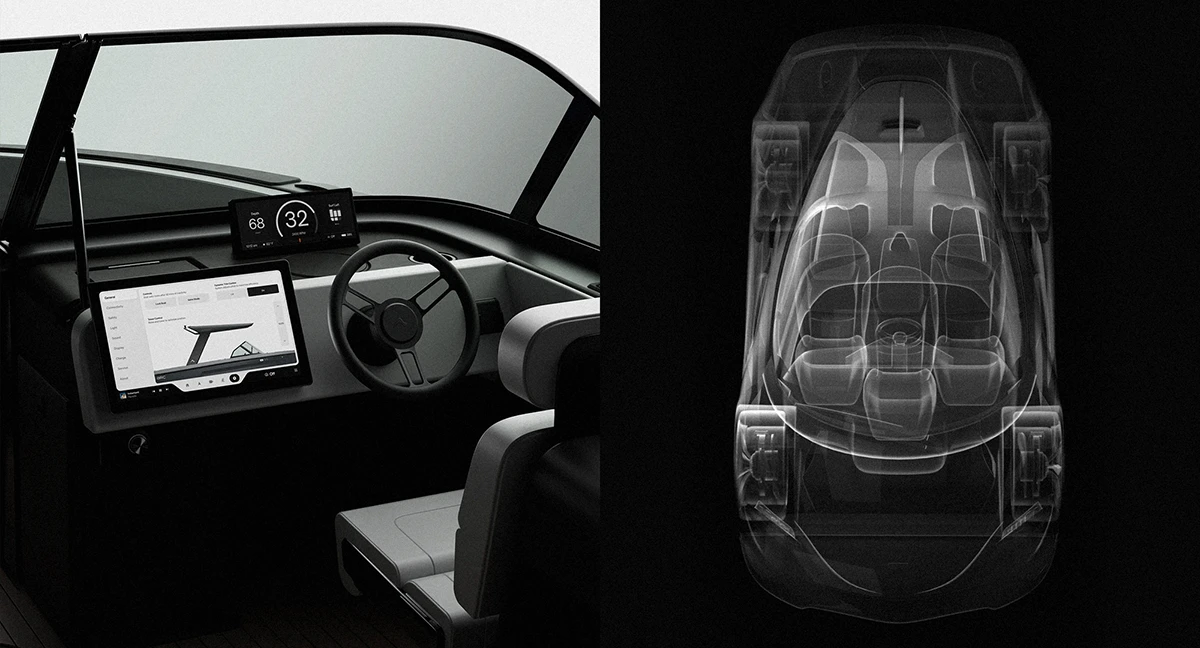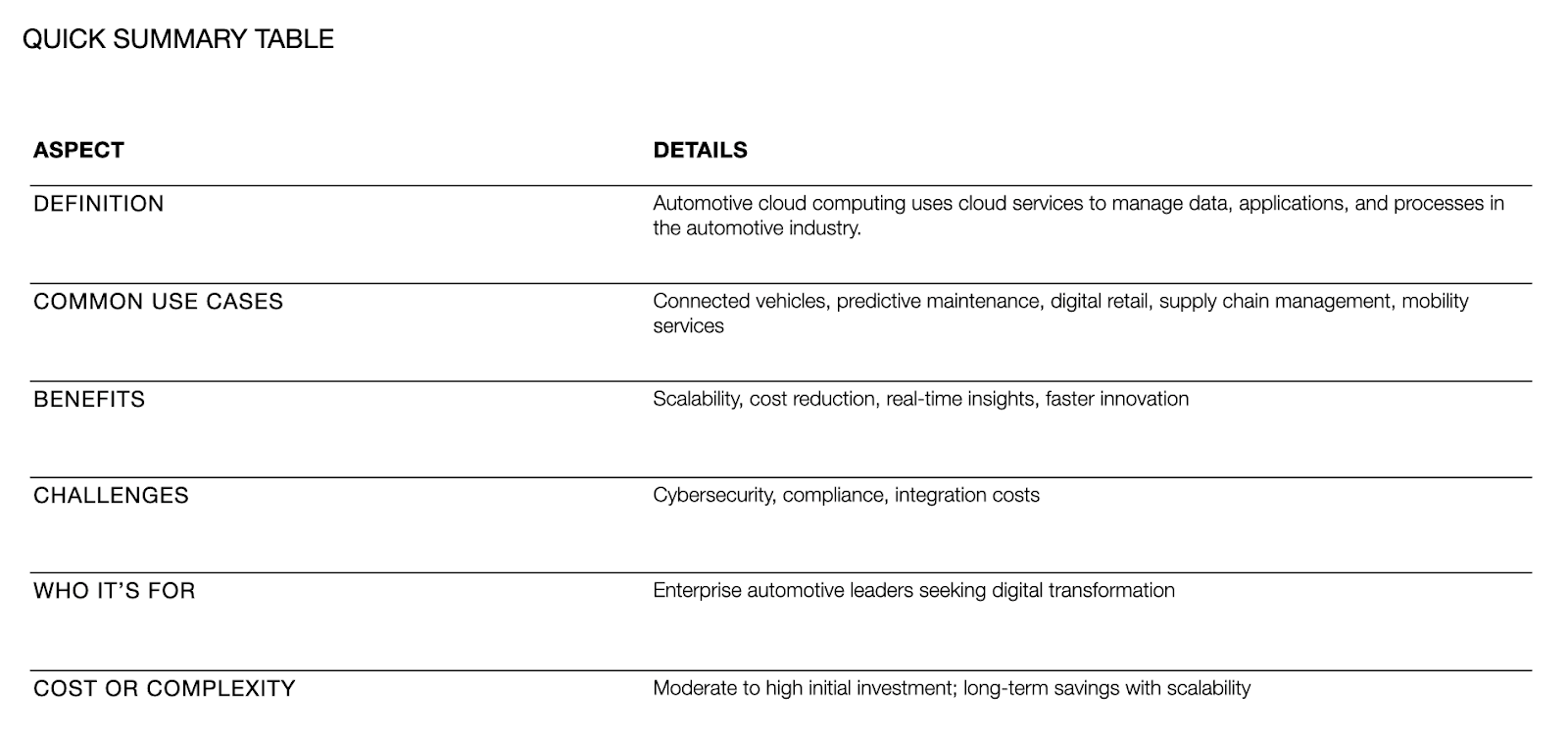
Automotive Cloud Computing FAQs | Cloud Computing in Automotive
Automotive companies are under pressure to innovate while cutting costs and delivering connected experiences. Yet many leaders remain uncertain about how to adopt cloud computing effectively. This article breaks down common questions about automotive cloud computing and explains what executives need to know to make smart decisions.
Senior leaders in the automotive industry—Directors, SVPs, VPs, and Heads of enterprise brands—will find clarity here on cloud computing in automotive industry practices, benefits, and challenges. You’ll leave with a sharper understanding of how cloud computing for automotive can help create competitive advantage and when to rely on expert partners for execution.
Market Context: Disruption & Opportunity
The automotive industry is evolving rapidly with digital ecosystems, connected vehicles, and intelligent supply chains reshaping operations. Traditional IT infrastructures are struggling to keep pace with this transformation. Cloud computing in the automotive industry is emerging as the backbone of modern mobility, powering everything from over-the-air updates to predictive maintenance.
Cloud computing for automotive industry players matters because it reduces cost, improves scalability, and enables real-time data insights. Without adopting automotive cloud computing, brands risk falling behind competitors that are leveraging cloud-native platforms for innovation and customer engagement. The opportunity is clear: companies that integrate cloud computing in automotive will be positioned to create smarter, more agile, and customer-focused business models.
FAQs Snapshot

What is automotive cloud computing?
Automotive cloud computing is the use of cloud platforms and services to manage, analyze, and store data across automotive ecosystems. It powers connected cars, digital retail, supply chain visibility, and smart manufacturing. In simple terms, cloud computing in automotive industry operations provides flexible infrastructure for delivering better mobility services.
Why is cloud computing important in the automotive industry?
Cloud computing in the automotive industry is essential because it enables real-time communication, data-driven decision-making, and seamless connectivity. For example, cloud computing for automotive allows continuous software updates, predictive analytics, and integration with mobility platforms. These capabilities help automakers stay competitive and meet rising customer expectations.
How does cloud computing in automotive work?
Cloud computing in automotive leverages shared servers, storage, and applications hosted in the cloud rather than local IT systems. It connects vehicles, suppliers, and customer touchpoints through a central ecosystem. This model allows the cloud computing automotive industry to scale services, reduce downtime, and accelerate innovation.
What are the challenges of cloud computing for automotive?
While cloud computing for automotive industry adoption offers benefits, it also presents challenges such as cybersecurity risks, high integration costs, and compliance with data regulations. Executives must balance these risks with the opportunities of cloud computing in the automotive industry, often requiring expert guidance.
When should automotive companies invest in cloud computing?
Brands should consider investing in cloud computing for automotive when scaling digital services, implementing connected vehicle platforms, or modernizing IT systems. For companies with outdated on-premises infrastructure, moving to cloud computing automotive industry platforms creates long-term efficiency and agility.
Can cloud computing scale with global automotive operations?
Yes, scalability is one of the biggest advantages of automotive cloud computing. As businesses expand, cloud platforms can support growing data volumes, additional geographies, and more connected devices. This makes cloud computing in automotive industry settings ideal for global enterprises.
Benefits of Automotive Cloud Computing
The benefits of automotive cloud computing extend beyond IT cost savings. For automotive enterprises, cloud adoption enables faster innovation, seamless customer experiences, and resilient operations. By implementing cloud computing in automotive industry strategies, organizations can achieve real-time analytics, improve collaboration across ecosystems, and ensure business continuity.
Specific outcomes include:
- Agile product development through cloud-based design and testing
- Enhanced customer satisfaction with real-time updates and connected services
- Cost efficiency by reducing on-premises infrastructure maintenance
- Better risk management with secure, scalable cloud architectures
- New revenue streams through mobility-as-a-service platforms powered by cloud computing in the automotive industry

Let’s kickstart the conversation and design stuff people will love.

Deep-Dive Sections

What It Is & Why It Matters
Automotive cloud computing refers to the application of cloud platforms for running automotive operations. It matters because automotive companies are generating unprecedented amounts of data from vehicles, customers, and supply chains. Without cloud computing in the automotive industry, managing this data becomes inefficient and costly. By adopting cloud computing for automotive, enterprises can integrate digital services, streamline manufacturing, and deliver better customer experiences.
How It Works
Cloud computing in automotive works by moving IT functions—like storage, computing power, and applications—into remote cloud infrastructure. Vehicles, dealers, and customers connect to this infrastructure through APIs and digital platforms. For example, cloud computing automotive industry solutions allow vehicles to receive over-the-air updates in minutes instead of requiring a physical recall. This operational agility is critical in today’s competitive environment.
When to Use It (and When Not To)
Cloud computing for automotive is best used when companies need to scale rapidly, adopt connected services, or modernize outdated IT systems. For instance, enterprises deploying mobility services or predictive analytics gain huge advantages from cloud systems. However, companies with limited digital maturity or heavy legacy investments may struggle with immediate adoption. In such cases, a phased approach to cloud computing in automotive industry systems may be more effective.
Tools or Platforms Involved
Several major platforms power automotive cloud computing, including AWS, Microsoft Azure, and Google Cloud. Each offers specialized automotive solutions like connected vehicle platforms, digital twin technologies, and IoT integration. Selecting the right cloud computing for an automotive industry provider depends on enterprise goals, existing systems, and scalability requirements.
Cost Considerations
Costs of cloud computing in the automotive industry vary depending on usage, scale, and vendor. While there are upfront expenses in migration and integration, long-term benefits include reduced infrastructure costs, flexible pricing models, and improved efficiency. Enterprises should weigh total cost of ownership against the long-term advantages of cloud computing for automotive.
Integration or Setup Requirements
Integrating automotive cloud computing requires assessing legacy systems, ensuring cybersecurity protocols, and aligning with compliance requirements. Migration typically involves phased adoption, with hybrid setups blending on-premises and cloud resources. Successful implementation of cloud computing for automotive industry leaders often requires consulting support to avoid delays and cost overruns.
Scalability & Flexibility
One of the strongest advantages of cloud computing automotive industry platforms is scalability. Enterprises can expand storage, computing power, and service delivery without heavy hardware investment. This flexibility allows automakers to roll out new features quickly and scale connected services across markets.
Alternatives or Comparisons
Alternatives to automotive cloud computing include traditional on-premises IT or private data centers. However, these lack the scalability, cost efficiency, and innovation capacity of cloud computing in automotive. Hybrid cloud solutions often provide a middle ground, enabling companies to balance compliance with scalability.
Trends
Key trends in cloud computing for automotive include the rise of software-defined vehicles, expansion of mobility-as-a-service, and use of AI-driven analytics. Cloud platforms are enabling automotive enterprises to integrate AI, IoT, and blockchain into their ecosystems. These trends confirm the growing necessity of cloud computing in automotive industry transformation.
Pros and Cons
Pros of automotive cloud computing include scalability, agility, cost reduction, and innovation enablement. Cons include integration complexity, data security risks, and potential vendor lock-in. Executives must weigh these factors carefully when evaluating cloud computing for automotive.
How G&Co. Can Help

At G&Co., we have partnered with enterprise automotive leaders to guide them through cloud adoption. Our experience spans strategy, digital integration, and optimization of cloud ecosystems. We know what works and what doesn’t in the cloud computing automotive industry because we’ve helped brands translate cloud initiatives into measurable impact.
Talk to us to clarify your strategy and move forward with confidence.
Conclusion & Next Steps
Cloud computing in the automotive industry is no longer optional—it is a critical enabler of future growth, efficiency, and customer satisfaction. We’ve clarified what automotive cloud computing is, why it matters, and how executives can approach adoption with confidence.
At G&Co., we’ve worked alongside clients to implement similar shifts—whether through digital strategy, customer journey redesign, or platform modernization. Our expertise enables brands to translate trend awareness into tangible market advantage.
Still have questions? Reach out and let’s solve them together.






%20(1).png)






